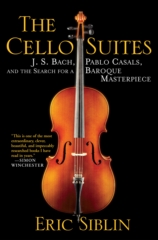Book review--Cello Chronicles
J.S. Bach, Pablo Casals And The Search For A Baroque Masterpiece
By Eric Siblin
Atlantic Monthly Press
Possibly a literary equivalent of Francois Girard’s film, The Red Violin, Canadian journalist/writer Eric Siblin’s The Cello Suites blends mystery, with biographies that read as multiple narratives. Certainly this page turner transforms the stuff shirt-stiff wig image of J.S. Bach into a man of intrigue and the cello from a melancholic to a magical instrument. Siblin’s journey into the Bach realm began when his career as a pop music journalist was on the wane and he stepped into a concert hall where the mysterious Cello Suites were performed, all 6 of them. This journey led the author to Belgium, France, Spain, and even to discoveries in his hometown, Montreal. He learns cello, joins a Bach chorale camp, and explores the Cello Suites in depth—experiential journalism.
While the readers are left hanging in regard to the suite’s origins, Siblin draws his own conclusions about each of the suites. “The second suite will forever remain for me a suite of tragedy, the third, love; the fourth, struggle; and the fifth mystery…The sixth suite is one of transcendence.” Well, with those descriptions, I played Pablo Casals’ recording of the first three suites (the library doesn’t have volume 2 with suites 4, 5, and 6). And just like watching The Red Violin (several times), drew me back to listening to and exploring classical music, Siblin’s book has transformed my views of J.S. Bach. However, my favorite sections of the book contain biographical information about Casals, his plight and the author’s discoveries also proved intriguing.
I’m amazed at the in depth information that Siblin weaves into a mere 270 pages. Obviously this author conducted thorough research, not just of the baroque era, or the Victorian era in which Casals began his long career, but also the modern era and its interpretations of Bach’s repertoire. Readers are immersed in multiple points of view from staunch Bach society types to pop stars flirting with Bach’s most famous works. And we are left with enough material here to form discussion groups to delve into the history of music, contemporary uses, and source purity. In the end, the mystery of Bach’s Cello Suites might never be solved and musicians will still take liberties in interpretations (think Glenn Gould’s interpretation of the Goldberg Variations) or a guitarist tackling the Cello Suites.
I’ve covered enough early music to come across debates about purity of sources, composers’ original intentions. New scores, manuscripts and letters surface about early music works that alter opinions and the facts. J.S. Bach composed and performed music in the 17th and 18th century. Music, instruments, and technology has transformed drastically since the baroque era. And it’s as Siblin and other early music aficionados have brought up, that we can’t possibly hear baroque music in the same way as our baroque era equivelents. We are inundated with music from around the world, immersed in commercial jingles, pop songs, and we listen to music differently through 2oth and 21st century technology.
The Cello Suites offers a fantastic read full of intrigue, history, and music. Narratives weave into each other seamlessly and beautifully. Facts flirt with literary moments, history bends with contemporary times. And no one has created such an enticing image of J.S. Bach since Glenn Gould dusted off Bach’s piano work and introduced it to the world’s concert halls in the 1950s. Bach's Cello Suites might just be the next Goldberg Variations, if it isn't already. And for those readers who relegated Bach to the boring confines of the Lutheran Church or the cello to the closet, might find themselves rethinking their views. Cellos might just be as adventurous as electric guitars.
http://www.groveatlantic.com




Comments
Post a Comment